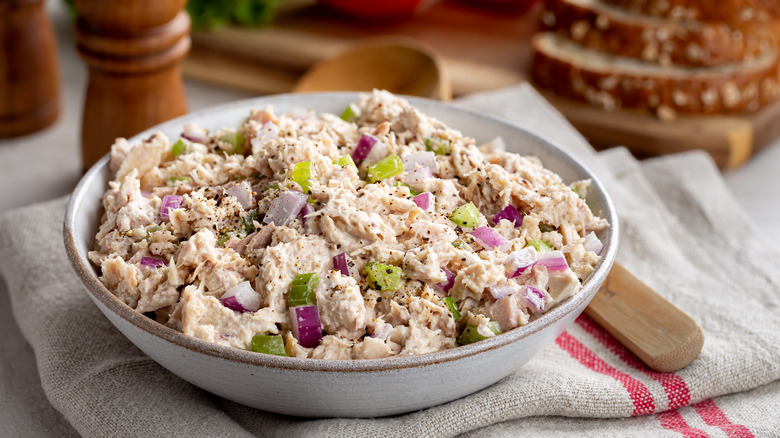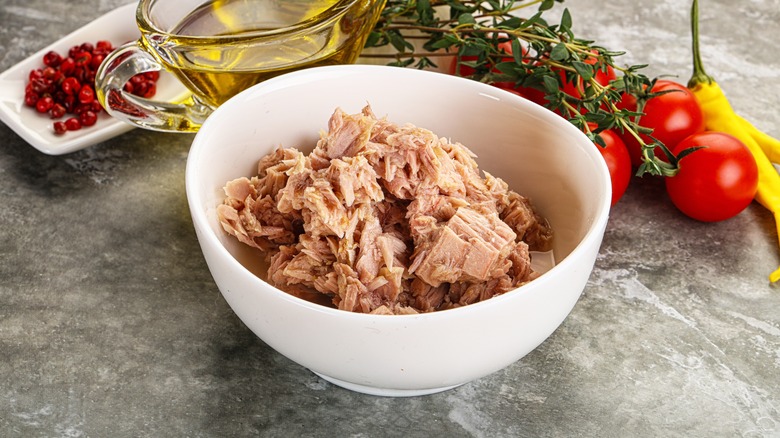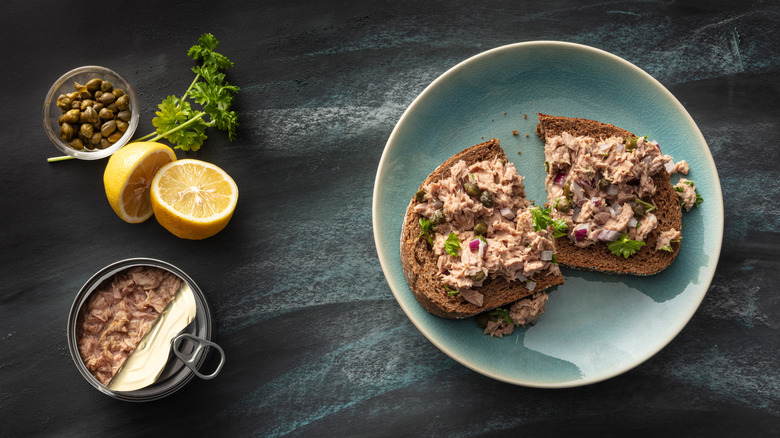You Can Freeze Tuna Salad — But There's A Catch
If you want to prolong your batch of tuna salad, it can last in the freezer for up to two months. That's because the main fishy ingredient, which is typically canned, is already cooked. And cooked foods have a longer period of preservation, including most meats.
However, if your tuna salad has mayonnaise (a main ingredient in most recipes), just know that it won't freeze well. It will have a completely different texture and taste when you go to eat it. When mayo is frozen and thawed, the large ice crystals that formed in the freezer will start to melt, and the emulsification of water, oil, and eggs will separate. And that will leave the condiment — and your salad — a grainy, curdled mess.
Your tuna salad will still be completely safe and edible, but it may not look very appetizing. If you plan to extend your tuna salad's shelf-life by throwing it in the freezer, you may want to consider some ingredient alternatives.
What to use instead of mayo in tuna salad
When choosing a mayo substitute for tuna salad (or any cold salad) you'd like to freeze, it's best to look for a condiment that will thaw into its original texture when the dish is ready to serve. If you're looking for a similar taste and texture to mayo, Greek yogurt can be easily frozen if prepped properly and is an excellent substitution for mayo in tuna salad. It provides a thick, creamy texture with a hint of sourness, matching that certain tang that mayo provides.
Another option that freezes well — but will be different from tuna salad made with mayo or yogurt — is hummus, which can be frozen for up to 4 months and defrosted into its original texture. Olive oil will also thaw into its normal consistency after being frozen. But if you use these two options, just know the final won't look or taste like the dairy-based tuna salad you're used to throwing together. So, if you're looking to mimic the creamy texture of mayo while also looking to freeze it, Greek yogurt is your best bet.
When it's time to enjoy it, frozen tuna salad needs to be thawed properly, so leave it in the fridge and let it thaw gradually, similar to how you would with meat. This is the best way to maintain the salad's quality and freshness for as long as possible.
What happens to tuna salad mix-ins in the freezer
Tuna salad can have endless variations and mix-ins, from fresh crunchy veggies to dried fruit. But if you're planning to make a batch ahead and store it, you should also choose mix-ins that will freeze well, just like you would with a possible mayo alternative.
Any mix-ins used in tuna salad are more likely to stay crunchy and fresh when they're stored in the fridge, and they may not be the same after you freeze them. Crunchy raw vegetables used as mix-ins (like celery, carrots, pickles, bell peppers, etc.) will become limp when thawed after a spell in the freezer. When frozen, the water inside the plant cells turns to ice crystals and expands, rupturing the cell walls and causing thawed veggies to lose their crispness.
But, cooked vegetables will have a better chance of freezing well and maintaining their original texture when thawed; that is if you take the added step of blanching your veggies before putting them in your tuna salad. Carrots and celery, for example, can last for three months in the freezer if you blanch them first.
You can also save your mix-ins and add them in fresh after your tuna salad comes out of the freezer. If you choose to forego all of this prep, know that plain, cooked tuna fish can go into the freezer as well, and you can simply add your mayonnaise and mix-ins after it's thawed.



